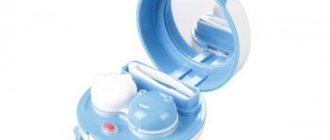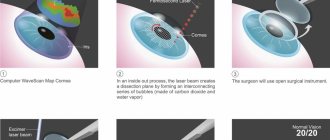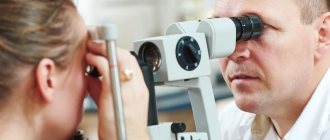Deep cleaning of lenses helps remove protein deposits, residues of aerosols and cosmetics, and destroy 100% of germs and viruses. To carry it out, peroxide solutions and enzyme tablets are used.
During wear, contact optics gradually become dirty. Multifunctional and universal solutions that are suitable for daily hygiene are excellent at removing surface contaminants. Peroxide and enzymatic cleaning of contact lenses is required for those optical products whose replacement period exceeds one month. Most often it is carried out for quarterly and traditional optical products. The recommended frequency is once every two to three weeks.
Peroxide cleaning of contact lenses is carried out using solutions that contain hydrogen peroxide. Such cleaning systems come in one-stage and two-stage types. In the first case, a special container with a titanium disk is used as a neutralizer for aggressive hydrogen peroxide. In the second, neutralization of the substance occurs using an enzyme tablet.
Enzyme cleaners are available in the form of soluble tablets. Their main function is to break down proteins, eliminating the most complex protein deposits that accumulate on the surface of products and can cause irritation and inflammation of the eyes.
Let's take a closer look at several popular products for peroxide and enzymatic cleaning of contact optics.
One Step
Peroxide solution from the manufacturer Sauflon contains 3% hydrogen peroxide, thanks to which it effectively fights microbes.
The product involves a one-step cleansing process in just one procedure. No additional moisturizing or rinsing is required.
The main advantages of the One Step peroxide system:
- high-quality cleaning and disinfection of contact lenses;
- hypoallergenic due to the absence of preservatives in the composition;
- the presence of a special container included in the kit, which neutralizes hydrogen peroxide after cleaning and ensures eye safety when putting on contact lenses.
Peroxide contact lens cleaning systems - pros and cons.
Probably not many people remember, but the first soft contact lenses required weekly heat treatment for care and disinfection. Simply put, the container with the lens was placed in a water bath, where it was heated in boiling water for 20 minutes. From the point of view of destroying microorganisms, this was quite effective, but convenience was clearly in question.
And the inevitable deformation of the lens during heat treatment did not add supporters to this method. Therefore, at first we thought about where to buy good lenses, and then we dreamed of somehow simplifying the process of caring for them. (At one time, the author personally burned three pairs of lenses due to boiled water). Thank God, since that time quite a lot of special CL care products have appeared on the market. But all their diversity comes down to several types, namely:
- Multifunctional solutions.
- Enzyme systems.
- Peroxide systems.
It is the last type that we will dwell on in more detail. The action of any peroxide system is based on the disinfecting ability of a 3% solution of hydrogen peroxide (H2O2).
This solution for contact lenses very effectively destroys bacteria, spores, fungi, yeast, and viruses - in general, everything that can appear on the surface of a contact lens during use. Moreover, peroxide is able to penetrate even microbial biofilms, which is not yet possible with conventional multifunctional solutions, more details on the page https://mkl.ua/category/universalnye-rastvory/. True, for high-quality disinfection it takes at least 6 hours, so peroxide systems are recommended for nightly use. But, in addition to bacteria and viruses, hydrogen peroxide also has a negative effect on the cornea of your eye, so another very important part of the peroxide system is the neutralizer. The mechanism of its action may be different, the main thing is that after following the instructions absolutely exactly, we receive a clean, disinfected lens that can be put on immediately.
A point that must be taken into account is that after neutralization, the H2O2 solution turns into a liquid in which the growth of microorganisms is quite possible. Therefore, all MKL peroxide systems are intended for disinfection and cleaning only. Storing lenses, even in a neutralized and seemingly harmless solution for the eyes, is not recommended!
- So, the obvious advantages of peroxide systems:
- The absence of preservatives means that a negative reaction of eye tissue to these preservatives is excluded.
- Effective cleaning and disinfection.
- When used correctly, they extend the life of the CL.
- Reduces the risk of eye redness when wearing lenses for a longer period of time.
- And, unfortunately, the downsides:
- Long time of H2O2 neutralization, excluding immediate use of lenses.
- The system is not very easy to use and there is a possibility of user error.
- In rare cases, allergic reactions may occur.
Instead of output:
Personal experience of using peroxide systems for four years (by two family members) has been only positive. The transition to such a system was caused by “a low sensitivity threshold in relation to components ... etc.” The meaning of this intricate medical saying boiled down to a simple one - the usual multifunctional solution turned the eyes red and caused pain. The current method of disinfection is well tolerated. So in a situation where you have to choose between completely refusing to wear contact lenses, or just a slightly more complex option for caring for them, it makes sense to try using one of the many peroxide systems.
Did you like the article? Share with your friends!
915
SIMILAR MATERIALS
Similar materials
Aosept Plus
The Aosept Plus one-step peroxide cleaning system is suitable for different types of lenses. It has no preservatives and is recommended for people with hypersensitive eyes and a tendency to allergies. The composition contains the preservative Poloxamer, which effectively moisturizes and disinfects optical products.
The product effectively destroys pathogens and removes protein and fat deposits. The special container that comes with the solution is equipped with a platinum catalyst, which, after purification, turns hydrogen peroxide into an eye-safe liquid.
Queen's Peroxide
Queen's Peroxide solution is produced by Soleko SPA. This product is suitable for cleaning and deep disinfection of contact optics made of soft polymer materials. It has hypoallergenic properties and is suitable for people with frequent allergic reactions. The product effectively removes all types of bacteria and germs, so after using it there is no need to resort to additional cleansing with enzyme tablets.
The solution can only be used in conjunction with a special container that neutralizes hydrogen peroxide.
Instructions for use
Before using the solution, you must read the instructions, which will consist of the following steps:
- You should wash your hands first.
- You can now open the lens holder and place the left contact lens on its convex part.
- Repeat the procedure with the right lens.
- Rinse the lens thoroughly for 5 seconds.
- Fill the container with Aosept Plus solution to the indicated level.
- Insert the lens holder into the container.
- Stand your container upright. If bubbles begin to appear from under the lid, then the solution may not be completely neutralized. After the procedure, the container must be thoroughly washed and rinsed with saline solution. After this, wash your hands and repeat the procedure.
Additional information about Aosept Plus solution
- Contact lenses should be left in the solution for at least 6 hours.
- After this period, the lenses can be removed from the container and are ready for use.
- Discard the solution and rinse the container with sterile saline solution.
- Dry the container.
- If you do not plan to use the lenses after disinfection, then they can be stored in a neutralized solution in an unopened container for up to 14 days. Disinfection must be carried out every 14 days.
Avizor International Enzyme
These enzyme tablets from the manufacturer Avizor contain substances that effectively break down protein while being gentle on contact lens material. The main component of the cleaner is subtilisin, a microbiological enzyme that is directly responsible for the breakdown of proteins and their rapid removal from the surface of the optical product.
With high efficiency, this component is safe for the eyes.
The main advantage of Avizor International Enzyme is the high-quality cleaning of the lens surface from protein deposits, which allows you to forget about eye discomfort.
Sauflon Trizyme
Enzyme cleaner from Sauflon is a soluble tablet for deep cleaning of the surface of contact optics from protein deposits. To clean two lenses, you will need one Sauflon Trizyme tablet dissolved in a multifunctional solution. Keep ophthalmic products in this solution for at least eight hours.
This product contains protease, lipase, pronase and other active components that effectively break down protein. An important advantage is that the cleaner contains no components of animal origin.
Before purchasing peroxide or enzyme tablets for contact lenses, consult your eye doctor.
What is an Enzyme Contact Lens Cleaner?
In order for contact lenses to provide clear vision and wearing comfort, they require careful care, which necessarily includes removing protein deposits from the surface of the lenses. Special enzyme cleaners for contact lenses do this job best.
All users of scheduled replacement lenses (bi-weekly, monthly, quarterly) are aware of the need to clean and care for their lenses daily. Multifunctional lens solutions are ideal for this purpose, providing disinfection, removal of deposits and contaminants, as well as rinsing and moisturizing contact lenses. However, lenses with a long replacement period (more than one month) accumulate more protein deposits, and a conventional multi-purpose solution cannot always completely clean the lenses of these deposits. Therefore, it is recommended to additionally use enzymatic cleaners to care for such contact lenses. With their use, you can be confident in the minimal risk of inflammation, as well as in the clarity of vision in the lenses and in wearing them comfortably for the eyes.
Operating principle of enzymatic lens cleaners
As the name suggests, enzymatic cleansers are based on enzymes that break the chemical bonds of protein molecules and break them down into simpler particles - peptides and amino acids. Those, in turn, easily pass from the surface of the lenses into the solution, and the lenses remain clean. Thus, enzymatic cleaners are able to remove even complex protein deposits attached to the surface of lenses that a multifunctional solution cannot remove.
Types of Enzyme Cleaners
Enzyme contact lens cleaners can be sold in different forms: powder for diluting a solution
,
effervescent enzyme tablets
or
ready-made solution
. When purchasing powder or enzyme tablets, it is important to remember that you can only use a freshly prepared enzyme solution - it should not be stored or used more than once.
Always read the instructions carefully before using enzyme cleaners, as an incorrectly prepared or used solution can cause severe eye irritation. In addition, different enzymatic cleaners have different modes of use: you can choose a solution for daily deep cleaning of contact lenses or for using the cleaner once every 7 to 10 days.
How to Buy Enzyme Contact Lens Cleaner
When choosing an enzymatic contact lens cleaner, carefully research whether it is suitable for your contact lens type. Select an enzyme cleaner or enzyme tablets with a mode of use that suits you and carefully follow the manufacturer's instructions when using.
If you have questions about the selection and use of an enzyme cleaner for your type of contact lenses, you can contact the Focus optical salons.
(Ekaterinburg), where a specialist will answer all your questions. You can also undergo an eye test and consult an ophthalmologist right in the salon.
We will be waiting for you in any of our salons at the following addresses:
st. Malysheva, 108 tel.: 273-67-13
st. Metallurgov, 87 STC "Mega" tel.: 379-30-13
st. Gagarina, 33 tel.: 287-07-89
st. Anton Valek, 12 tel.: 273-94-27
st. Julius Fuchik, 1 tel.: 264-36-56











